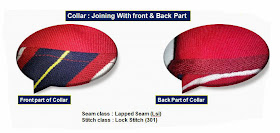Cutting section is one of the most
important sections for manufacturing garments in Garments Factory. To
fabric cut out pattern pieces of garment components as per exact
dimension of the patterns from a fabric lay is called fabric cutting. It
is totally different from general cutting in which exact dimension is
not taken into account. The term fabric cutting is only applicable for
garments manufacturing technology.
Requirements of Fabric Cutting:
The following points must be fulfilled in fabric cutting:
Precision of fabric cutting:
Fabric cutting should be done accurately as per exact dimension of the
pattern pieces in the marker. Accurate cutting depends on methods of
cutting and marker planning. If manual cutting method is used, then
cutting accuracy depends on sharpness of knife, skill of operator, and
attentiveness of operator. Computer controlled cutting and die cutting
have their self cutting accuracy.
Consistent cutting: Whatever
be the cutting method used for fabric lay cutting, it should be ensured
that the shape of the cut components from top to bottom lay are of
exact size and shape, otherwise the garments produced will be defective.
Infused edge: During
fabric cutting, the friction between the fabric and the blade produces
temperature in the blade; the temperature may be up to 3000C. If the
fabric contains synthetic fibers e.g. nylon, polyester, acrylic or their
blends, then fused edge may result in the fabric. Because most of those
fibers melt at around 2500C. Therefore, sticking of cut edge of fabric
will increase the fabric wastage. Moreover, the fused edge after cooling
will form hard bid, which will be a problem of irritation during use of
garments.
To avoid the problem of fused edge formation, the following steps may betaken:
- Reduce the height of the lay
- Reduce the cutting speed
- Use anti-fusion paper in the lay at regular interval
- Lubricate the knife during cutting
Supporting of the lay: Surface
of the cutting table depends on methods of fabric cutting. The table
surface should be capable to support the lay as well as to ensure that
all the plies are cut at a time during fabric cutting.















.png)


